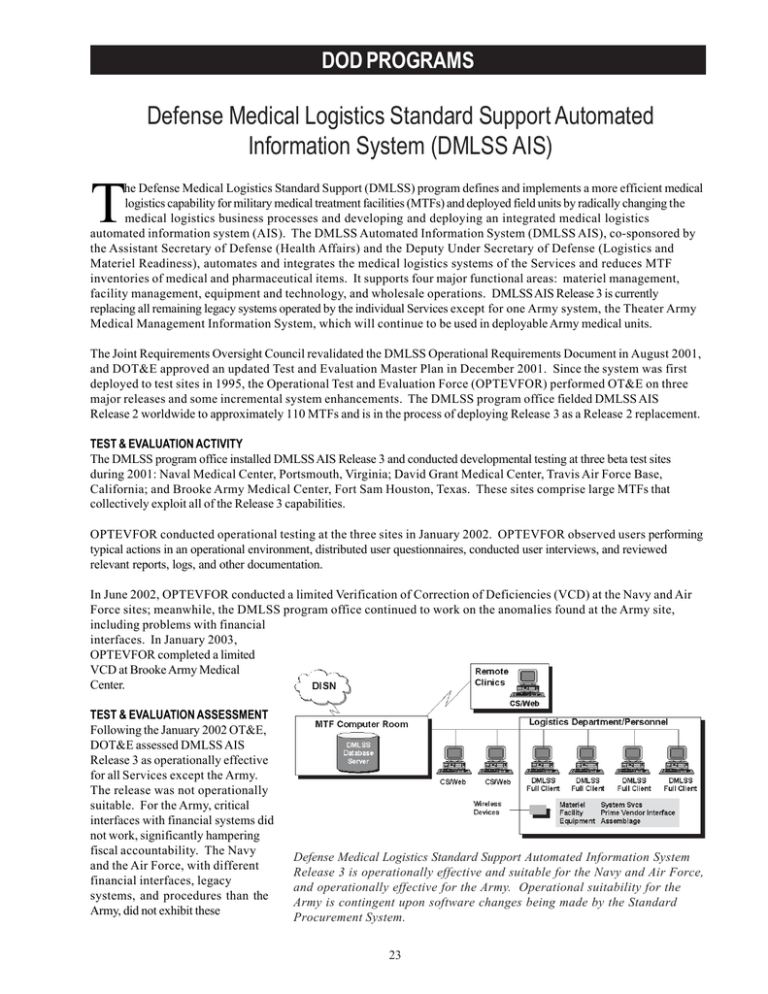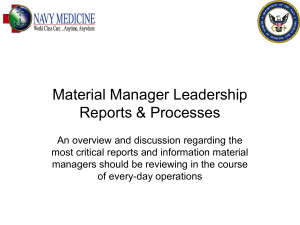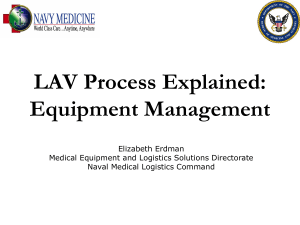T Defense Medical Logistics Standard Support Automated Information System (DMLSS AIS) DOD PROGRAMS
advertisement

DOD PROGRAMS Defense Medical Logistics Standard Support Automated Information System (DMLSS AIS) T he Defense Medical Logistics Standard Support (DMLSS) program defines and implements a more efficient medical logistics capability for military medical treatment facilities (MTFs) and deployed field units by radically changing the medical logistics business processes and developing and deploying an integrated medical logistics automated information system (AIS). The DMLSS Automated Information System (DMLSS AIS), co-sponsored by the Assistant Secretary of Defense (Health Affairs) and the Deputy Under Secretary of Defense (Logistics and Materiel Readiness), automates and integrates the medical logistics systems of the Services and reduces MTF inventories of medical and pharmaceutical items. It supports four major functional areas: materiel management, facility management, equipment and technology, and wholesale operations. DMLSS AIS Release 3 is currently replacing all remaining legacy systems operated by the individual Services except for one Army system, the Theater Army Medical Management Information System, which will continue to be used in deployable Army medical units. The Joint Requirements Oversight Council revalidated the DMLSS Operational Requirements Document in August 2001, and DOT&E approved an updated Test and Evaluation Master Plan in December 2001. Since the system was first deployed to test sites in 1995, the Operational Test and Evaluation Force (OPTEVFOR) performed OT&E on three major releases and some incremental system enhancements. The DMLSS program office fielded DMLSS AIS Release 2 worldwide to approximately 110 MTFs and is in the process of deploying Release 3 as a Release 2 replacement. TEST & EVALUATION ACTIVITY The DMLSS program office installed DMLSS AIS Release 3 and conducted developmental testing at three beta test sites during 2001: Naval Medical Center, Portsmouth, Virginia; David Grant Medical Center, Travis Air Force Base, California; and Brooke Army Medical Center, Fort Sam Houston, Texas. These sites comprise large MTFs that collectively exploit all of the Release 3 capabilities. OPTEVFOR conducted operational testing at the three sites in January 2002. OPTEVFOR observed users performing typical actions in an operational environment, distributed user questionnaires, conducted user interviews, and reviewed relevant reports, logs, and other documentation. In June 2002, OPTEVFOR conducted a limited Verification of Correction of Deficiencies (VCD) at the Navy and Air Force sites; meanwhile, the DMLSS program office continued to work on the anomalies found at the Army site, including problems with financial interfaces. In January 2003, OPTEVFOR completed a limited VCD at Brooke Army Medical Center. TEST & EVALUATION ASSESSMENT Following the January 2002 OT&E, DOT&E assessed DMLSS AIS Release 3 as operationally effective for all Services except the Army. The release was not operationally suitable. For the Army, critical interfaces with financial systems did not work, significantly hampering fiscal accountability. The Navy and the Air Force, with different financial interfaces, legacy systems, and procedures than the Army, did not exhibit these Defense Medical Logistics Standard Support Automated Information System Release 3 is operationally effective and suitable for the Navy and Air Force, and operationally effective for the Army. Operational suitability for the Army is contingent upon software changes being made by the Standard Procurement System. 23 DOD PROGRAMS effectiveness deficiencies. DOT&E assessed the releases as not operationally suitable based on deficiencies in logistic supportability, training, and documentation. In May 2002, the Program Manager corrected these deficiencies and invited immediate verification of his corrective actions. In June 2002, OPTEVFOR performed a VCD at the Navy and Air Force sites and found all deficiencies were corrected with one remaining anomaly – an automated materiel management quality control feature requiring workaround. From October 28, 2002, through January 24, 2003, OPTEVFOR performed a VCD for the Army and determined that all known deficiencies had been corrected, with the exception of interoperability with the Standard Procurement System (SPS), the correction of which will require software changes by the SPS program in order to interface with DMLSS AIS Release 3. This interface is intended to automate the Army’s ability to order certain items not readily available through the normal supply process. The users can order these supplies manually, but with greater effort. As of May 2003, the DMLSS AIS Release 3 is operationally effective and suitable for the Navy and Air Force, and operationally effective for the Army. Operational suitability for the Army is contingent upon software changes being made by SPS. Additionally, the DMLSS Operational Requirements Document requires interfaces to systems still in development. As these systems become operational, DMLSS will interface with these systems and conduct additional OT&E to verify successful performance and interoperability. 24


